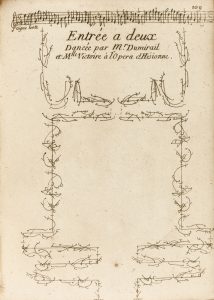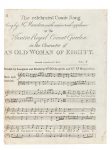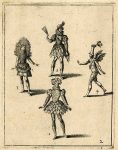First edition of the first dance treatise to provide a complete codification of ballet arm positions—a major landmark in both ballet and data visualization. Malpied’s Baroque dance manual prescribes dance movements using the innovative notation system published in 1700 by Raoul Auger Feuillet—the coiner of the term chorégraphie. His method “shows a marked advance on the work of Feuillet and Rameau in the simplification of the recordings of dance steps” (Fletcher). With the standardization of five ports de bras, or arm positions, to match the five foot positions developed over the previous century, “the neoclassical demand to harmonise content and appearance had taken hold of the entire body” (Weickmann). Malpied, a dancing master who operated in the shadow of the Paris Opera, also describes here the minuet and l’allemande—two forms of popular dance in favor at the time. There is an undated second edition with 166 pages. Fletcher no. 37; Leslie, p. 337; Magriel, p. 82; Moroda, p. 378; see Dorion Weickmann, “The ballet d’action of the eighteenth century,” in The Cambridge Companion to Ballet (2007).
Octavo (204 x 145mm). [8 pp.] 122 pp. Entirely engraved. Engraved title signed Ribie’re; music and dance notation and diagrams throughout (slight darkening and soiling to title, dedication leaf strengthened at inner margin). Modern quarter calf over marbled boards (faint wear). Provenance: Edward Tufte (1942-present, pioneer in the field of data visualization and information design; bookplate, his sale, 2 December 2010, lot 51).
Sold for USD 6,000 at Christie’s in 2019
Leaflet, Raoul-Auger ( 1659 / 1660-1710 ). COMPLETE OF DANCES CONTAINING VERY LARGE NUMBERS, BIG ENTRANCES OF BALLET OF MR PECOUR. PARIS: SHEET, 1704. first edition , 6 pages, 228, 16, [2] pages, large in-8 (23.2 x 16.8 cm), dedication, preface, musical notation and dance notation, the last sixteen numbered pages include the ” Airs of Dances contained in this Recüeil which fills table with this Volume “and an excerpt of the privilege, slip for the announcement of the publisher, half-vellum of the eighteenth century, text cropped runs on some pages, leaflet of the announcement of the detached publisher , slight foxing, some small spots, some discharges of engravings, breaks between the leaves sometimes appearing the back of the back.
An extremely rare copy of one of the most important works related to dance, containing Feuillet’s dance notation system. This volume has not appeared in public sale for thirty years. Unlike previous choreographic methods, which simply described dance steps verbally, Feuillet uses a visual representation of diagrams to account for the dancer’s tricks, jumps and slips and his movements across the dance floor. The attractive and distinguished prints of Feuillet include the appropriate dance tunes at the head of each board. Among the dances described in this volume are saraband, chaconne, passacaille, bourée, and canarie for two men.
Sold for EUR 21,150 at Sotheby’s in 2012
![MALPIED (fl. 18th century). Traite´ sur l'art de la danse. Paris: M. Bouin, [c.1770]](https://antiquemusicals.com/wp-content/uploads/2019/01/musical-manuscript-dance-213x300.jpg)


